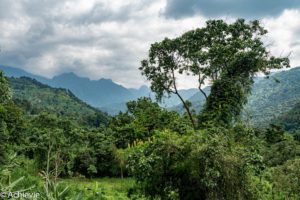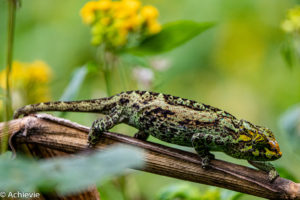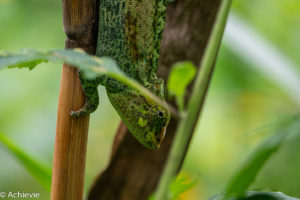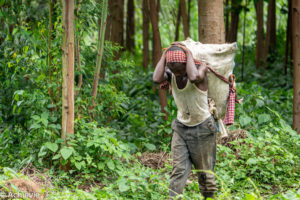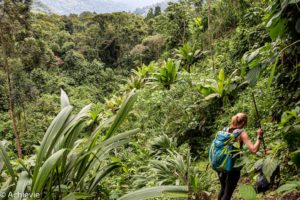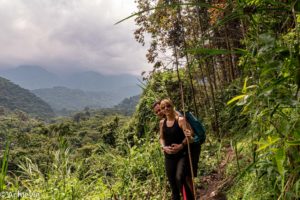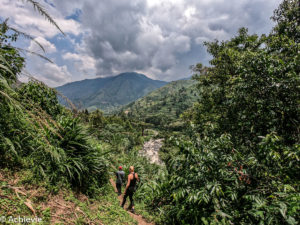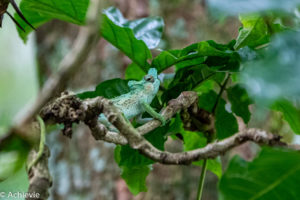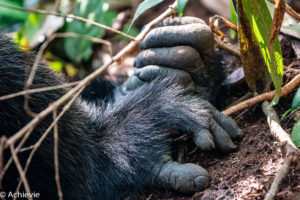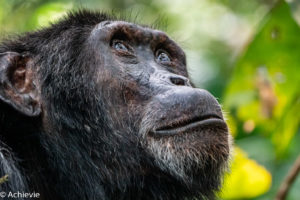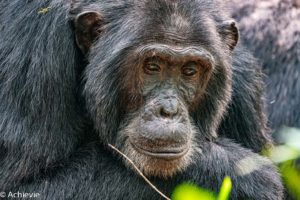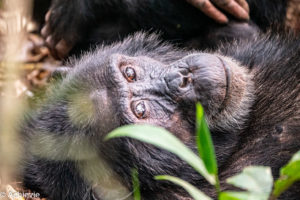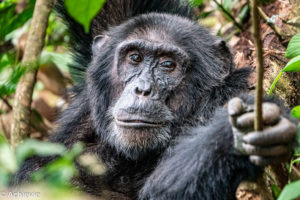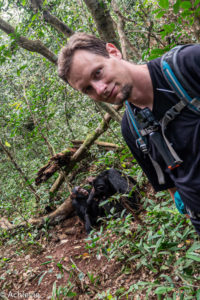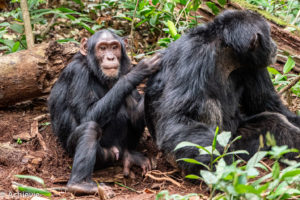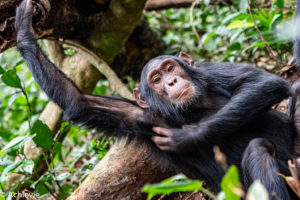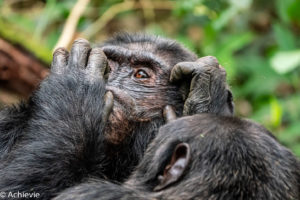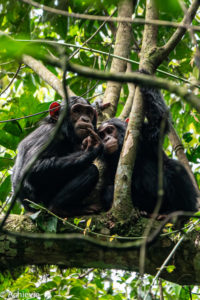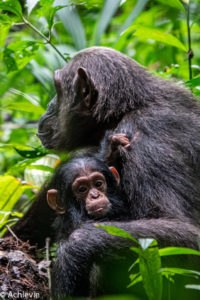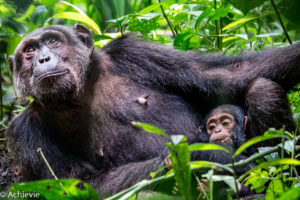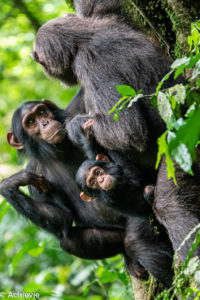Getting there – Stop at Rwenzori Community Camp
Coming from Queen Elisabeth National Park, we wanted to make a stop at Rwenzori Community Camp before continuing to Rweetera Safari Camp, which is the accommodation we would be staying at for launching our chimp experience. It’s not that long of a drive – it took us a little less than 2 hours before getting at the Rwenzori Community Camp. If you follow the GPS, make sure to not take the little side roads, but look out for the bigger ones that usually end up at the same place, but are a lot more convenient for the car and will not get you stuck. At a certain point we did take one of those side roads and got to a point where we needed to cross the river, but weren’t unable to as there was no bridge allowing any cars, so we needed to turn back. We only saw a sign on the road pointing to the Camp at the last 5 kms before the camp; if you come from opposite directions, there’s a sign on the main road to the National Park.
The camp has an amazing setting – at one side there’s the mountains continuing into Congo, in front there’s uphill farm ground that’s turning into forest. Arrived at Rwenzori Community Camp, a kind lady helped us with arranging both lunch as well as a guide to take us for a walk. There’re several possibilities: a community walk which takes up to 3 hours and is easy, a forest walk which takes about 3 to 4 hours and is moderate and an uphill walk, which takes about 5 to 6 hours and is strenuous. As we wanted to make it to the Rweetera Safari Camp before 6pm at the latest, we chose the forest walk.
Jacob was our friendly guide and showed us around the forest. Before getting there we crossed the water, then went through farm land (a lot of women and children going up and down with heavy bags of crops on their backs) and finally we made it into the forest. As it had rained the day before, the muddy soil wasn’t the easiest – a lot of slippery descents and actually more climbing than we needed to do for the gorilla trekking. Blue monkey, black and white colobus as well as vervet monkey can be found in the forest, but we haven’t seen any. What we did see were two types of chameleons – the three horned (although we only saw the females, without the horns) and the plate-nosed chameleon. We had indicated our interest to catch the three-horned on camera, so Jacob was so kind to help us with find it – it’s just impossible to see them ourselves. Even if he pointed at it, it was difficult to distinguish it from the leaves or the branches. For the one-horned, it was actually 3 other guys who we had passed on the walk back from the forest who pointed them out.
It took us about 2 hours, which was ideal to stretch our legs, get out of the car, see something different and got energized for our last part of the trip to Rweteera Safari Camp.
Getting from Rwenzori Community Camp to Rweteera Safari Camp
If you would also like to pay a visit to the Rwenzori Community Camp and get to Kibale National Park afterwards, make sure to take the main road and not the “shortcut” dirt roads. In the end I’m guessing it takes you equally long.
We did take the dirt roads and we have been worried at times. When we were at about 75% of the route, we ended up in the plantations, on a road that didn’t look like it was built for cars to go through. It was so narrow and the people on it needed to jump on the side. Were we relieved when we got onto an actual dirt road again, even though it was rocky. We thought that was it, but the last 5km before reaching our destination, we were again directed to a small dirt road which was rather steeply going down. Don’t know why, but first we tried it – we were that far already – but when we felt the tires slipping away on the muddy ground, we asked some VOORBIJGANGERS whether this was actually a road we could take. Two of the three clearly said no – one was actually laughing at us: “Turn around!”. So we did – or we tried. Now the car was really slipping away and it was a narrow road, with a AFGROND. It we slipped into the wrong direction, this could get ugly. Luckily we slipped into the right direction and my husband drove the car back up. I got out, avoiding any OVERBODIGE weight to pull up. I was happy to see he made it back up the hill. We studied the GPS alternative routes again and found another way – adding only a few additional minutes to the estimated arrival time. Were we happy to have arrived at the camp after 2 hours of adventure!
So, if you wanna avoid the cold sweats, just take the main road. If you like a thrill now and then, then the “shortcut” is the way to go – we did have a lot to see on our way there, that’s for sure!
Our unforgettable Chimp Experience
In order to get to the launch point on time, we needed to get up at 5am. That allowed us to have breakfast at Rweteera Safari Camp at 5.30am and leave somewhat before 6am, so that we arrived at about 6.10am – which is perfect, as you need to be there between 6 and 6.30am. There was another group of 8 Americans joining us today. We got a briefing of what was going to happen and then got split up into 2 groups, one group of 6 (our group) and one of 4. Both groups would join several times throughout the way.
You can opt to take a porter, as with the gorillas, which we didn’t do. Our guide Gordon, armed with a rifle, was the one accompanying us on this trip, which started at about 7am. He explained us how to look for chimp, by hearing their calls, looking for chimp pooh on the ground and tracks of their knuckles as they move on the ground. Quite soon, one of the American guys said he saw a chimp high up in the trees. He even got a picture of it. Looked promising… Somewhat further we saw a lot of monkeys (they told us it was red-tailed monkey, red colobus and mangabey, but they were way too high to really take a good look at them, let alone photograph them.
So we continued, watching at moving branches, looking up at every sound. Suddenly Gordon stopped and was pointing to the right side, saying that there was an elephant. We only saw bush moving, but no actual glimpse of an elephant.
We went further down the forest, crossing the road and going into the other side of the forest. By then we were about 3,5 hours further and we were starting to get worried. Gordon said that also the day before they didn’t see any non-habituated chimps. So we were going to the habituated ones (means the chimps who already got used to people). Before we knew it we saw 4 of them sitting and laying together on the ground, very close to us (about 4 or 5 meters). A lot of other people were standing around it, all trying to get the best shot. Apparently, several groups of travellers got together (about 4 or 5 of them). One by one they left, leaving our group behind with all the opportunity in the world to further study them.
The different chimps came and went. Before we knew it we were surrounded by them. The calls they make and the noise that follows is chilling… Felt like we got into the Planet of the Apes movie. There were chimps high up in the trees, the ones on the ground got agitated and started moving around, running and taking leaves from the ground with them, so they made even more noise. This went on for a while, the calls and yells coming and going. We followed the alpha male (named “The Orphan”) for a while. Suddenly, he came forward, showing his teeth, yelling in the direction of my husband – who froze (as the guide told him to stay where he was). Pretty impressed and not knowing what he had done wrong, Gordon explained that this was quite normal and that he was not aiming at my husband, but just communicating with the rest of the group.
As he continued his path, we followed. Other chimps running alongside us, others following higher up, swinging from tree to tree. Until they suddenly stopped. And then continued again. An interesting scene. We would not stop filming – there was too much going on. We didn’t know where to look first.
Around noon, we sat on a tree branch to eat our lunch and let it all sink in. We took our time, then got our things together again and continued following several chimps. We saw it all – a mother with her baby, the alpha male again – this time farting as he was laying in the grass, juvenile chimps acting very much like humans, some serious grooming taking place, others climbing up and down trees, two younger ones playing and jumping on branches before their mother snapped at them… This continued until about 2pm and then we headed back to the meeting point where they would pick us up. Somewhat before 3pm we were back at the Center.
Oh – and one tip if you make this trip. If you stand still and the chimps are above your head, make sure to watch out for pee (and pooh) coming down. We had it a few times that we saw rain of pee and were able to duck away, right in time before it hit us. We do believe they were aiming at us…
Other Countries we visited
Have a look at the other countries we ‘achievied’ to visit, and other Achievies…

